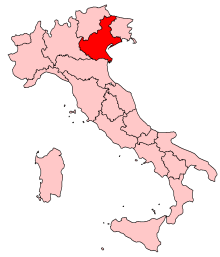Introduction to the region: Veneto
The Veneto region is often dominated by a focus on the capital city, Venice. As Thomas Mann, German author of the novella Death in Venice wrote: “This was Venice, the flattering and suspect beauty this city, half fairy tale and half tourist trap.” Venice is one of the most distinctive cities in the world, but the first time I visited in 2007 could be a lesson in ‘what not to do.’ To be honest, we only really went wrong with lodging and not completing sufficient research about where to eat, getting caught in the ‘tourist trap’ warning that Mann already warned about 100 years before.
I remedied the lodging dilemma in the summer of 2011, as we stayed in a beautiful, central Airbnb. We had views over the canals with gondolas floating by like clockwork, and could reach Saint Mark’s Square in 5 minutes on foot (although everything is either on foot or by boat in ‘the floating city’). You will find central options in abundance on the Airbnb site, and I absolutely recommend this option for your accommodation in Venice. Rather sadly, tourism is one of the only profitable industry on the island now; thus, many private owners have converted inherited family houses into rental properties.
Padova is my chosen city highlight for the Veneto region. It is more of a ‘hidden gem’ and the art history heritage is still quite overlooked and overshadowed within the region. Thus, I have, instead, highlighted the glorious Venezia as a regional feature because I can confidently recommend sites and museums not to miss, and Venice, of course, is not to miss. Hopefully the subsequent posts will encourage you to add Padova to your Veneto itinerary as well! In addition to Padova, my city of choice, Verona is another treasure to explore. I spent a charming weekend getaway with my mom in Verona in 2010, and while now, I would personally do more research than I did pre-trip, I remember walking the city in a blissful state. Read more in the regional features post. (Updates coming soon!)
The Veneto region at large is becoming quite popular for the ‘bubbly’ aspect of her character. With this burgeoning popularity of prosecco and the increased interest in travel experiences that move beyond world capitals, the perception of the region is changing. Therefore, instead of planning a trip to only Rome, Florence and Venice, many people are opting to travel by region (as I mentioned in the about me section as well). Veneto is a perfect region for this type of experience. Read more about the Valdobbiadene wine growing area in the food and wine post.
I will feature the majesty of Italian lakes in the Lombardia section, but here in Veneto, Lago di Garda also makes an appearance. In fact, Lake Garda boasts the title of largest Italian lake; because of its size it spans three northern Italian regions, Lombardia, Trentino -Alto Adige and here in Veneto. Therefore, you can add a lake stop to your regional experience, if desired.
I want to add a bit of information about some specific history in this region. Most people have heard a whisper about Venice as a former ‘republic’; I know I had, but I was fascinated by some of the details when I actually delved into the history in a more serious way. The Republic of Venice, given the epithet La Serenissima (the most serene), existed from 697 CE to 1797 CE, just over 1,000 years. Specifically, Venice existed as a ‘maritime republic’ also called a thalassocracy as ‘thalassa’ is the Greek word for ‘sea’. Venice was indeed a ‘seaborne empire’ dominating and controlling a number of costal territories in the Mediterranean.
I am more familiar with the history in the latter part of the republic’s existence because it forms the context for the play Othello by William Shakespeare, one that I have lovingly taught for many years. Shakespeare published Othello between 1601-1604 and it takes place around 1570-1571 when the characters who represented the Venetian republic were at war with the Ottoman Empire to control the island of Cyprus. Although he never visited Europe, Shakespeare drew inspiration from reliable accounts of these events and used the history as a backdrop for his romantic tragedy. In fact, the title character Othello initially holds the prestigious position of General in the Venetian army, even though he is discriminated against as a moor and outsider. Examining power and race relations is generally the thematic focus in an English classroom, yet understanding the context of the Republic of Venice is critical.
The republic ended with the invasion of Napoleon Bonaparte in 1797. Even a basic understanding the history of the Venetian republic will contribute to a greater enjoyment of the capital city, Venice. For example, the impressive Doge’s Palace, just near Basilica di San Marco was the residence of the supreme rulers, the ‘doges’, of the republic.
As you can see from the map at right, the territory of the Republic covered most of the current Veneto region and also all along the Dalmatian coast, modern day Croatia. You will find similarities in the cuisine from this Croatian region which date back to the shared history.


